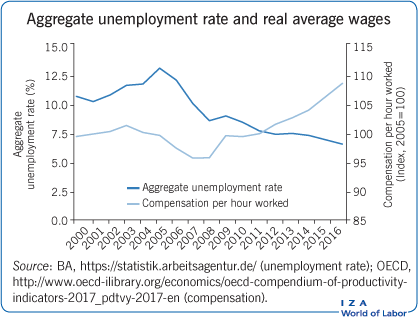Elevator pitch
The EU’s largest economy, Germany, has managed to find an effective and unique combination of flexibility and rigidity in its labor market. Institutions that typically characterize rigid labor markets are effectively balanced by flexibility instruments. Important developments since 2000 include steadily decreasing unemployment rates (since 2005), increasing participation rates, and (since 2011) moderately increasing labor compensation. The German labor market has also been remarkably robust to the impacts of the Great Recession, thus providing a useful case study for other developed countries.

Key findings
Pros
Unemployment is generally low, but especially youth unemployment is very low by international comparison, which appears related to the dual apprenticeship system.
While participation rates have been basically increasing since the mid-2000s across the board, the increase was particularly strong among older workers.
Considering aggregate figures, Germany’s labor market has hardly been affected by the Great Recession—especially not in terms of aggregate employment.
The labor market remains rather rigid by international comparison, but the country manages to avoid many negative side effects that are typically associated with rigidity.
Cons
The trend toward favoring academic education over vocational training threatens the important role of the dual apprenticeship system.
Given comparatively high labor costs in Germany, it is important that the country remains productive and innovative.
The return of protectionism is a threat to the German model, which continues to rely to a substantial extent on exports and imports.
The reduction of unemployment during the last decade is mostly driven by demographic factors in east Germany. The unemployed do not proportionally benefit from the increase in employment.
Demographic change jeopardizes the sustainability of the country’s success, especially when taking structural disadvantages in immigration policy into account.